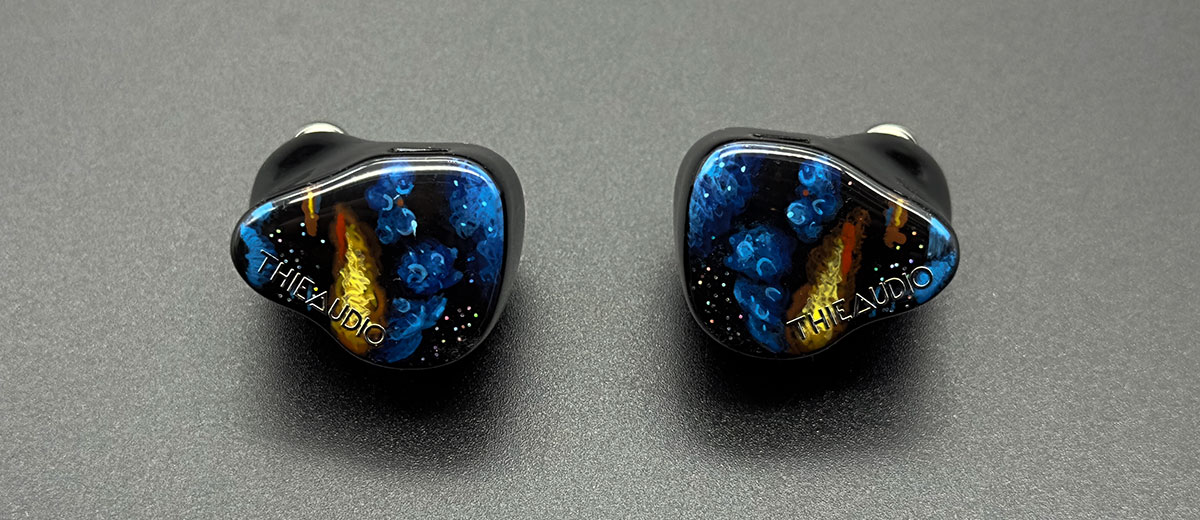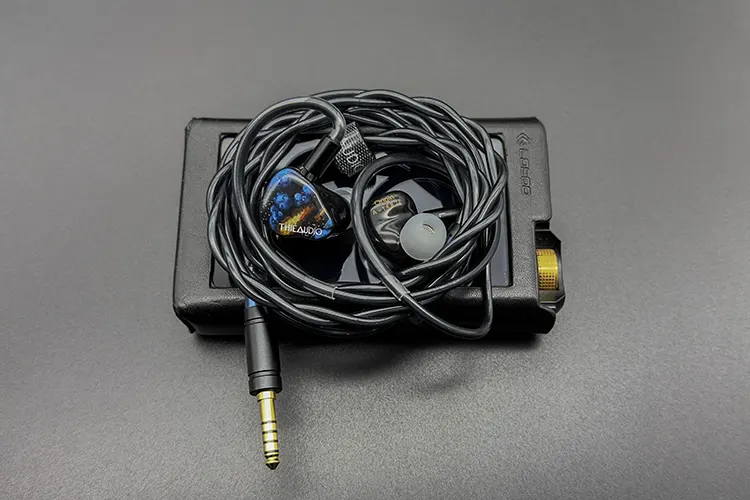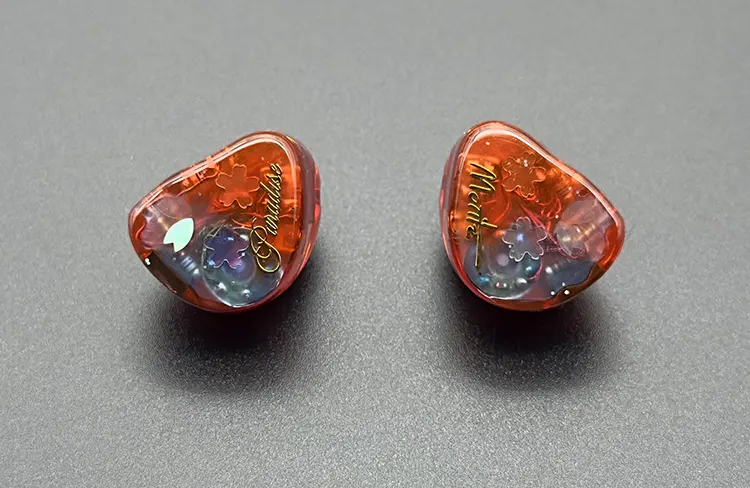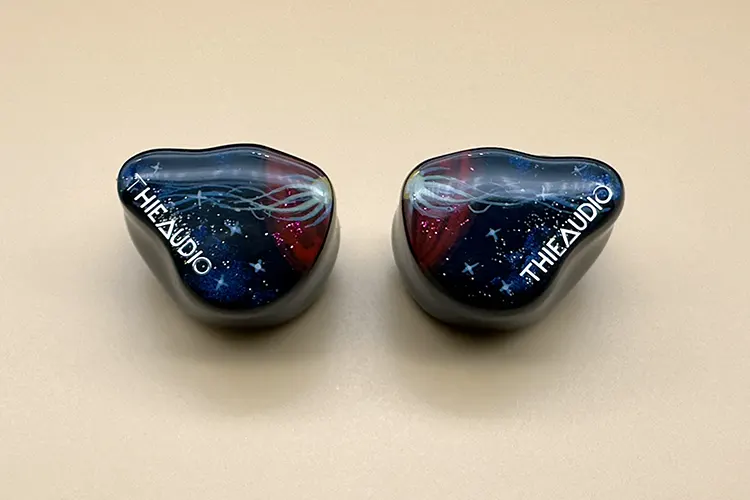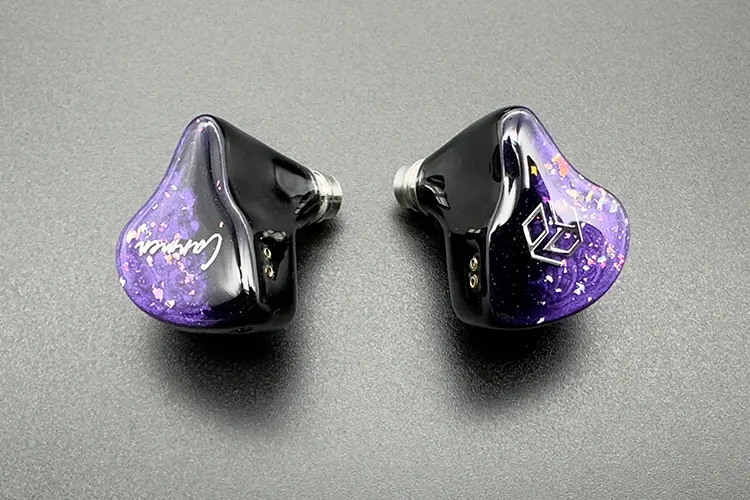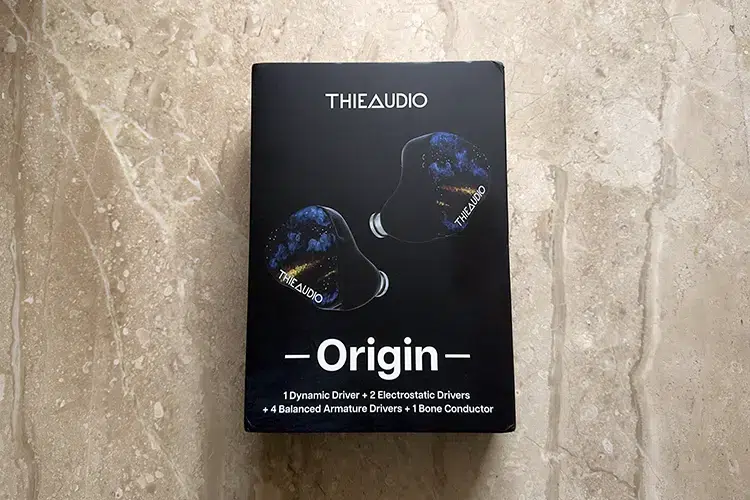Synergy
Efficiency
THIEAUDIO Origin has an impedance of 9Ω @ 1 kHz and a sensitivity rating of 102 dB/Vrms. The IEM can be comfortably driven by weaker sources such as dongles and smartphones.
Even if the Origin does not demand additional power, it benefits from a powerful source, as I find the stage expanding a bit and the notes gaining some weight as well.
The EST drivers can surely take some extra juice. With more power, the IEM scales well without getting overly sharp or harsh, showcasing excellent dynamics.
Source Pairings
The Origin paired effortlessly with most of the sources I tested. The LPGT brings out the best in it. The Origin benefits from the DAP’s power and warmth, resulting in a lush and rich sound with pleasing warmth without overwhelming the mix.
The bass has a satisfying body with excellent texture and layering. The midrange has added richness and the female vocals deserve special mention in this pairing.
The upper midrange to the lower treble region maintains decent energy, exhibiting a satisfying sense of openness. The LPGT adds depth to the soundstage, further improving layering and instrument separation.
On the Questyle CMA18P, which features an AKM 4493 DAC chipset, the Origin produces similar results. However, you won’t find the same level of micro-detailing as with the LPGT.
The CMA18P, being a very powerful device, helps the Origin open up a lot. The bass hits hard with authority, while the midrange is more neutral than it is on the LPGT.
The upper midrange to the treble region has a high level of energy and airiness. One area where it lags behind the LPGT is in the depth of the soundstage.
Select Comparisons
Moritz Audio Paradise
Technical
The driver configuration on Paradise features eight drivers per side. This setup includes dual dynamic drivers for the lows, a blend of four balanced armature drivers from Knowles and Sonion for the mids and highs, and dual bone conduction drivers from Sonion.
The Moritz Audio Paradise boasts an impedance of 7Ω and a sensitivity rating of 100 dB/Vrms. It demands a lot more power than Origin, and I do not find it pairing well with low-power sources.
On my LPGT, the Paradise can take volume levels nearing 50, while Origin comfortably remains at 35.
Design
The Paradise has an adorable, compact build. Its resin shells are crafted in a vibrant, transparent orange. The faceplate adds a touch of elegance with shiny, flower-shaped accents and subtle glitter elements. The Paradise also features three dip switches, allowing for three distinct tuning options.
The Origin, by contrast, has a very different design language. Built with an all-black body and an artistic faceplate, the Origin has larger shells that may pose a fit issue for people with smaller earlobes. The Paradise is more comfortable and its smaller shells almost disappear in the ears.
Both the Paradise and Origin use 0.78mm 2-pin connectors. The stock cables on both IEMs are modular, with interchangeable terminations. However, the Origin’s cable has better build quality and looks more premium.
While both IEMs include a well-thought-out set of accessories, the carry case included with the Paradise stands out. It provides more space, and the leather it is built with feels more premium.
Performance
Paradise has a more hard-hitting bass with more rumble and a sense of reverberation that adds depth, creating an intense, head-filling experience. The Origin, on the other hand, keeps the bass more controlled and does not overwhelm the mix.
The mid-bass on the Origin is better controlled, while the impact remains decent. Texture and layering are also handled better on the Origin. If you prioritize bass quantity, the Paradise may suit the basshead in you.
In the midrange, the Origin remains neutral, thanks to the minimal interference from the bass region. The Paradise has a slightly recessed midrange, where vocals feel pushed back.
Out of the three tuning modes on the Paradise, the midrange gets the best treatment on the Vocal mode, as the bass is less pronounced. However, even in Vocal mode, Paradise lacks the clarity and resolution offered by Origin.
In the upper midrange, the Origin portrays extension and details more effectively, while the Paradise occasionally exhibits thinness.
In the treble region, the Origin is the clear winner with its airy presentation and sufficient energy. On the Paradise, the tuning emphasizes smoothness, minimizing harshness and sibilance, resulting in a more relaxed upper range. This can come across as a bit dull to some.
The Origin delivers better detailing and extension in the treble region, whereas the Paradise produces thinner notes that dissipate quickly and often blend.
In technical aspects, the Origin is significantly ahead. The soundstage of the Paradise has average width but pleasing depth, creating a holographic feel that, while enjoyable, is not overly spacious.
In contrast, the Origin provides an impressive holographic experience with far-reaching width and depth. The Origin also excels in detail retrieval, bringing out details more vividly than the Paradise.
THIEAUDIO Hype 10
Technical
The THIEAUDIO Hype 10 is a hybrid IEM featuring dual dynamic drivers and ten balanced armature drivers. It incorporates the IMPACT2 technology common in the other Hype series IEMs, such as the Monarch MKIII and Oracle MKIII.
Hype 10 implements two dynamic drivers and ten balanced armatures. In the low-frequency region, Hype 10 incorporates two Sonion balanced armature drivers in addition to the dual dynamic drivers.
Hype 10 has an impedance of 18Ω @ 1 kHz and a sensitivity rating of 104 dB/Vrms. Like the Origin, it can sound full at lower volume levels and pairs well with sources of lower power specifications. On LPGT, both IEMs take a volume level near 35.
Design
Design-wise, both IEMs look quite similar. They have different color schemes and designs on the faceplates. There is a subtle design difference in the nozzles as well, while the dimensions are nearly the same.
Both IEMs feature similar resin shells, with the Origin having slightly larger shells. In terms of fit, both provide a comparable level of comfort. The Hype 10 does not push as much against my antihelix as the Origin does.
The Hype 10 and the Origin use a 0.78mm 2-pin connector and offer a modular cable with interchangeable terminations, including 4.4mm, 3.5mm, and 2.5mm options. The cable is thicker and stiffer on the Origin. I prefer the new cable on the Origin as it is aesthetically more appealing too.
As for accessories, while the packaging is similar for both, the internal arrangement and included accessories are different. The Origin comes with a different carry case, which I find more premium.
Performance
Origin and Hype 10 share similar THIEAUDIO characteristics. In terms of performance, they are quite close, but the Origin offers added fun with its more authoritative bass performance.
The vibrancy introduced by the bone conduction driver gives the Origin an edge if you prefer a more exciting tuning.
The bass on the Origin is more controlled, tighter, and punchier. While the sub-bass depth is similar for both, the mid-bass on the Origin is more accurate and precise.
The midrange of the Origin is smoother and warmer, resulting in a more musical presentation. In contrast, the midrange on the Hype 10 is more neutral.
While the Hype 10 offers better resolution, its presentation is more analytical and lacks the added richness found in the Origin. The Hype 10 features a more V-shaped profile with a closer-to-ear presentation.
In the upper midrange, the Hype 10 delivers more energy and detail, whereas the Origin is smoother but lacks some liveliness in this region.
Both IEMs have a similar treble profile; however, in the upper treble region, the Origin feels airier. In the lower treble, the Hype 10 exhibits greater energy and detail.
Where the Origin truly excels is in stage presentation. It offers a more holographic soundstage, noticeably stretching in all directions, which provides a greater sense of openness. The Hype 10 emphasizes resolution and clarity, prioritizing accuracy over musicality.
Yanyin Carmen
Technical
The Carmen is powered by ten balanced armature drivers. For the low end, Carmen employs four Sonion drivers. In the midrange, Carmen uses two Sonion drivers, while the high frequencies are managed by another pair of full-sized Sonion drivers.
Additionally, a custom dual driver is specifically dedicated to the ultra-high frequencies. The drivers are arranged in a 4-way crossover system with four independent sound bores.
Yanyin Carmen has an impedance of 10Ω @ 1 kHz and a sensitivity rating of 109 dB/Vrms. Like the Origin, Carmen can be very comfortably driven by sources with lower power specifications.
On my LPGT, both the IEMs take a volume level of 35. The Carmen, however, can take a few more clicks.
Design
Both IEMs feature similar resin shells, with the Carmen having smaller ones. The Origin faceplates showcase an artistic, abstract design with subtle shimmers, which I find just as beautiful as those on the Carmen.
While both IEMs are comfortable to wear, the Carmen offers a better fit due to its smaller shells. The nozzle on the Origin is slightly shorter and larger in diameter.
Both the Origin and Carmen use a 0.78mm 2-pin connector. The Origin includes a modular cable with interchangeable terminations, offering 4.4mm, 3.5mm, and 2.5mm options.
The Carmen is available with either 3.5mm or 4.4mm terminated cables, which can be chosen at the time of purchase. Both stock cables are nicely built.
In terms of packaging, the Origin provides a better experience. It comes in a large, spacious box with a thoughtfully included carry case and an extra set of foam ear tips.
The Carmen, on the other hand, has minimalistic packaging and does not include a carry case. Accessories differ, with the Origin arriving in a distinct carry case.
Performance
The Origin delivers a warm sound signature with a near-neutral tilt and an elevated bass range. It presents a smooth and rich midrange and treble without leaning toward an analytical profile.
The Carmen offers a more colored sound with additional warmth, which is more pronounced.
The Origin has a clear edge with its tight and bold bass body. While the Carmen has a sub-bass-focused response, it does not match the level of impact and depth found in the Origin.
In the mid-bass region, the Carmen lacks good impact. Its bass is fast and decays a bit quicker, dissipating faster, whereas the Origin’s bass exhibits the typical dynamic driver qualities of decay and a lingering effect. The Origin also outperforms in terms of texture and layering.
In the midrange, the Origin stays neutral, but the warmth it introduces makes the overall tuning engaging. The warmth in the Carmen can feel overwhelming at times, adding unwanted coloration.
The lower midrange on the Carmen is thicker and denser, while the Origin keeps it more toned down, showcasing its balanced tuning.
The Origin also achieves a better level of micro-detailing. Vocals feel more natural on the Origin compared to the thickened vocals on the Carmen.
In the upper midrange, the Origin offers better extension and detailing. In this region, the Carmen feels a bit tamed and smooth, lacking a sense of openness. The Origin’s treble provides better airiness and detail in comparison.
The Carmen falls significantly behind in the treble region, offering a smoother presentation that lacks energy and extension.
The Origin boasts a better soundstage, exhibiting a very spacious and holographic feel. Though the Carmen and Origin have a similar width in stage presentation, the depth feels better on the Origin. The Origin also fares better in instrument separation and layering aspects.
My Verdict
One of the reasons I appreciate THIEAUDIO as a brand is the variety of flavors they offer with every release.
With the Origin, they have delivered an IEM that is bass-heavy yet remains balanced across the frequencies. The bass is quite special, as is the added vibrancy and excitement brought by the inclusion of the bone conduction driver. It suits almost all genres and will delight those who love bass-heavy tracks.
Adding to this, the sweetness and level of detail it provides in the midrange and treble regions are quite impressive. There aren’t many things I would want to change in the tuning, though the shells could be a bit smaller.
For those considering alternatives to the Oracle MKIII or Hype 10, the Origin offers a distinct tuning with a delightful touch of fun and excitement. If you’re in the market for an IEM under $1000, you should try the Origin before deciding.
THIEAUDIO Origin Technical Specifications
- Driver Configurations: 1 Dynamic Drivers + 4 Balanced Armatures + 2 EST Drivers + 1 Bone Conduction Driver
- Frequency Response: 20 Hz – 44 kHz
- Impedance: 9Ω±1Ω
- Sensitivity: 102 dB (± 1 dB) @1kHz
- Cable: Silver-plated OCC cable, detachable 0.78mm 2Pin
- Modular Termination with 3.5mm and 4.4mm interchangeable plugs

